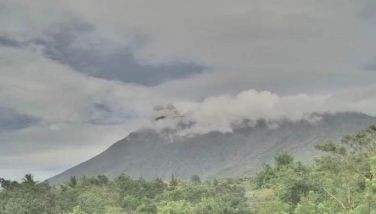IT harnessed to conserve Misamis’ Mt. Malindang
April 2, 2006 | 12:00am
LOS BAÑOS, Laguna – Information technology is now being harnessed to help conserve the country’s biodiversity.
An example is the development of the Mt. Malindang Biodiversity Information System (MMBIS), which focuses on one of Mindanao’s ecologically rich and valuable mountains that straddles Misamis Occidental.
Developed by researchers of the University of Southeastern Philippines (USEP) in Davao City, the Mt. Malindang Information System is a database management system that makes existing information easily available to policymakers, planners, and even future biodiversity researchers.
The MMBIS was designed to handle the voluminous data gathered under the "Philippines-Netherlands Biodiversity Research Program (BRP) for Development in Mindanao: Focus on Mt. Malindang and Environs."
Started in 2000 and to be completed this coming June, the program aims "to break new ground in developing a location-specific, interactive, and landscape approach to biodiversity research that will contribute to the conservation, restoration, and sustainable use of biological diversity in the Mindanao region" and thus, improve livelihood and cultural opportunities.
The BRP is being implemented by the Los Baños-based Southeast Asian Ministers of Education Organization-Regional Center for Graduate Study and Research in Agriculture (SEAMEO-SEARCA) with funding support from the Netherlands Ministry of Development Cooperation (DGIS).
The program’s research activities were undertaken by Dutch researchers and their Filipino counterparts from 14 academic institutions in Mindanao, among them the USEP.
The activities also involved stakeholders such as farmers, fisherfolk, local government units and non-government organizations.
Mt. Malindang has been chosen as the BRP site because it is a natural park and a priority protected area.
It has three major peaks, a rugged volcanic landscape and 78 rivers, all within 53,262 hectares of the Mt. Malindang Natural Park, the only remaining representative area of the Zamboanga Peninsula biogeographic zone, one of 15 such zones in the country.
A SEARCA report states that Mt. Malindang’s flora and fauna are rich: 494 species of plants, 99 species of birds, and 18 species of mammals (three of which are endemic). Of the animal species found in the park, 59 are listed as threatened, 22 rare and 15 endangered.
The USEP reported the development of the MMBIS during a recent research and development (R&D) symposium of the Southern Mindanao Agriculture and Resources Research and Development Consortium (SMARRDEC).
A group of R&D and academic institutions in Region 12, SMARRDEC is one of the 14 regional R&D consortia being coordinated by the Los Baños-based Department of Science and Technology-Philippine Council for Agriculture, Forestry and Natural Resources Research and Development (DOST-PCARRD).
The USEP-developed biodiversity information system contains forms that would allow researchers or authorized users to easily encode or input data from their respective researches into the system. This makes the system more advantageous than other traditional inputting systems.
Recurring or reusable data type is stored in the system’s libraries for easy retrieval.
The taxonomic (species classification) libraries include a list of all plants and animals found on Mt. Malindang, their taxonomic category, and some taxonomic descriptions such as conservation status and distribution.
The querying aspect is the part of the system where the user can ask questions or inquire about available data in the database to get additional information.
The system incorporates "easy-to-use" query forms that the users can just click on for each of the different fields.
The system also contains biodiversity data on the biophysical and socio-economic aspects of Mt. Malindang.
The USEP nonetheless suggested that the information system be further improved and that new technologies and global standards be further explored and, if possible, such information systems must be able to handle biodiversity information not only on Mt. Malindang but also on the whole of Mindanao.
An example is the development of the Mt. Malindang Biodiversity Information System (MMBIS), which focuses on one of Mindanao’s ecologically rich and valuable mountains that straddles Misamis Occidental.
Developed by researchers of the University of Southeastern Philippines (USEP) in Davao City, the Mt. Malindang Information System is a database management system that makes existing information easily available to policymakers, planners, and even future biodiversity researchers.
The MMBIS was designed to handle the voluminous data gathered under the "Philippines-Netherlands Biodiversity Research Program (BRP) for Development in Mindanao: Focus on Mt. Malindang and Environs."
Started in 2000 and to be completed this coming June, the program aims "to break new ground in developing a location-specific, interactive, and landscape approach to biodiversity research that will contribute to the conservation, restoration, and sustainable use of biological diversity in the Mindanao region" and thus, improve livelihood and cultural opportunities.
The BRP is being implemented by the Los Baños-based Southeast Asian Ministers of Education Organization-Regional Center for Graduate Study and Research in Agriculture (SEAMEO-SEARCA) with funding support from the Netherlands Ministry of Development Cooperation (DGIS).
The program’s research activities were undertaken by Dutch researchers and their Filipino counterparts from 14 academic institutions in Mindanao, among them the USEP.
The activities also involved stakeholders such as farmers, fisherfolk, local government units and non-government organizations.
Mt. Malindang has been chosen as the BRP site because it is a natural park and a priority protected area.
It has three major peaks, a rugged volcanic landscape and 78 rivers, all within 53,262 hectares of the Mt. Malindang Natural Park, the only remaining representative area of the Zamboanga Peninsula biogeographic zone, one of 15 such zones in the country.
A SEARCA report states that Mt. Malindang’s flora and fauna are rich: 494 species of plants, 99 species of birds, and 18 species of mammals (three of which are endemic). Of the animal species found in the park, 59 are listed as threatened, 22 rare and 15 endangered.
The USEP reported the development of the MMBIS during a recent research and development (R&D) symposium of the Southern Mindanao Agriculture and Resources Research and Development Consortium (SMARRDEC).
A group of R&D and academic institutions in Region 12, SMARRDEC is one of the 14 regional R&D consortia being coordinated by the Los Baños-based Department of Science and Technology-Philippine Council for Agriculture, Forestry and Natural Resources Research and Development (DOST-PCARRD).
The USEP-developed biodiversity information system contains forms that would allow researchers or authorized users to easily encode or input data from their respective researches into the system. This makes the system more advantageous than other traditional inputting systems.
Recurring or reusable data type is stored in the system’s libraries for easy retrieval.
The taxonomic (species classification) libraries include a list of all plants and animals found on Mt. Malindang, their taxonomic category, and some taxonomic descriptions such as conservation status and distribution.
The querying aspect is the part of the system where the user can ask questions or inquire about available data in the database to get additional information.
The system incorporates "easy-to-use" query forms that the users can just click on for each of the different fields.
The system also contains biodiversity data on the biophysical and socio-economic aspects of Mt. Malindang.
The USEP nonetheless suggested that the information system be further improved and that new technologies and global standards be further explored and, if possible, such information systems must be able to handle biodiversity information not only on Mt. Malindang but also on the whole of Mindanao.
BrandSpace Articles
<
>
- Latest
- Trending
Trending
Latest
Trending
Latest
Recommended




























